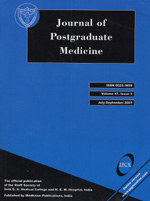
|
Journal of Postgraduate Medicine
Medknow Publications and Staff Society of Seth GS Medical College and KEM Hospital, Mumbai, India
ISSN: 0022-3859
EISSN: 0022-3859
Vol. 50, No. 2, 2004, pp. 94-97
|
 Bioline Code: jp04030
Bioline Code: jp04030
Full paper language: English
Document type: Research Article
Document available free of charge
|
|
|
Journal of Postgraduate Medicine, Vol. 50, No. 2, 2004, pp. 94-97
| en |
Thymoma: A pathological study of 50 cases
Vaideeswar Pradeep , Padmanabhan A, Deshpande JR, Pandit SP
Abstract
BACKGROUND:
A combination of epithelial cells and lymphocytes results in a varied histomorphology of thymomas and consequent varied classification systems.
AIM:
To correlate the Marino and Muller-Hermelink (MMH) classification with the invasive behaviour of thymomas.
SETTING AND DESIGN:
Retrospective analysis.
MATERIALS AND METHOD:
Thymomas encountered in the past 21 years were re-classified with the MMH classification and correlated with Masaoka's staging and clinical presentation.
RESULTS:
The thymomas formed 91% of the primary thymic epithelial tumours. Predominantly cortical thymomas (n=21) and cortical thymomas (n=22) were the common subtypes and 60% and 77% of these, respectively, were in stages II or III. Cystic change, necrosis or haemorrhage played no role in predicting invasive behaviour. Cortical epithelium correlated well with the presence of para-thymic syndromes, especially myasthenia gravis.
CONCLUSION:
MMH classification is easy to apply. Cortical thymomas in stage I should be followed up for possible recurrence.
Keywords
Thymoma, Marino Muller-Hermelink classification, Masaoka's staging
|
| |
© Copyright 2004 Journal of Postgraduate Medicine.
Alternative site location: http://www.jpgmonline.com
|
|
